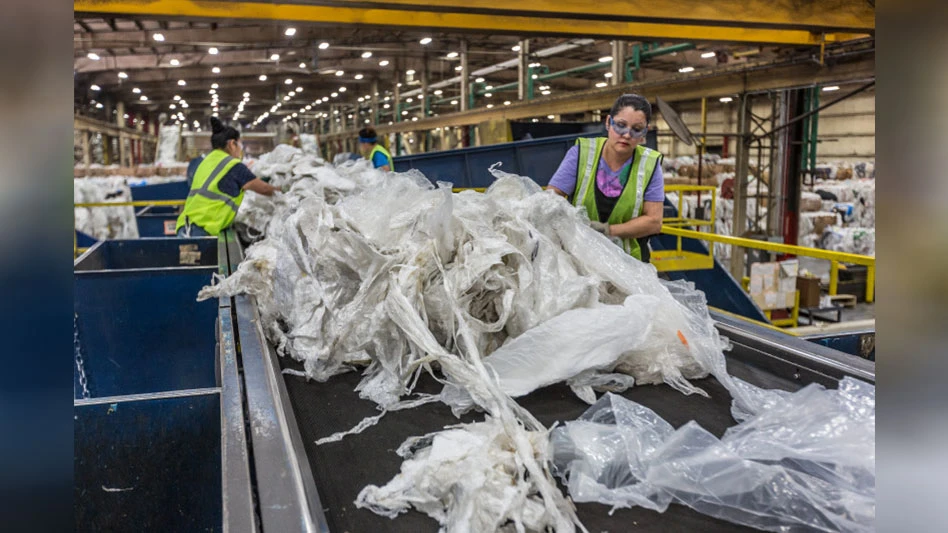
© Kyolshin | Dreamstime.com
Since California became the first state in the U.S. to require minimum postconsumer resin (PCR) content in plastic bottles with Assembly Bill 793, signed into law in October 2020, much has been discussed about the benefits of enacting minimum PCR content standards and how implementing these laws impacts recyclers and consumers alike.
California’s law sets a series of graduated minimum PCR-content standards for all plastic beverage containers—the first of which went into effect Jan. 1—and seeks to improve the recycled plastic market by increasing demand. According to AB 793, plastic beverage containers sold or manufactured in California must include at least 15 percent PCR by Jan. 1 at least 25 percent by Jan. 1, 2025, and at least 50 percent by Jan. 1, 2030.
The beverage container law follows a separate law in California that was signed in 2014. The law bans single-use plastic bags and requires all reusable plastic grocery bags be made with a minimum of 40 percent PCR. These reusable bags also must be recyclable and must be at least 2.25 millimeters thick, according to CalRecyle.
Mark Murray, executive director of Sacramento-based Californians Against Waste, said California has one of the nation’s most successful bottle bills, but more than 3 billion bottles still are dumped in landfills each year. Since China implemented its “National Sword” policy in 2018, banning the import of most postconsumer plastic scrap and other recyclables, so much more of that previously recycled material now ends up in landfills, he added.
These shortcomings surrounding plastics recycling have forced industry leaders to reevaluate their approaches to advocacy and legislation. In a webinar the Northeast Recycling Council (NERC) and the Northeast Waste Management Officials’ Association (NEWMOA) hosted Jan. 6 called Recycled Content Mandates: The Good, the Bad, and the Ugly, experts, including Murray, offered thoughts on how to continue improving recycled-content mandates for the best economic and environmental results.
“This experience in California, we’ve had some successes, we’ve had some failures, we’ve had a lot of false starts, and the main thing is it’s taken us an awfully long time to get to where we are,” he said. “But I would say that where we are right now is having a strong model for how do you advance and sustain producer responsibility for a circular materials economy.”
Recognizing producer responsibility was a key focus of the discussion. Murray said California’s law does a sufficient job of holding all manufacturers accountable for achieving the same rates of recyclability.
“The idea behind this is more than just creating markets for recycled material. It is ultimately making manufacturers partners in ensuring they have sufficient material to meet this requirement,” Murray said. “At the end of the day, this policy provides the ultimate incentive for the manufacturers to ensure that system is working to get this material back to them, and if they have to pay in order to do that, so be it.
“This is an even-playing-field way for all material types to comply,” he added. “The amount of material exists for them to comply with the recycled content requirement through actual utilization of the postconsumer material.”
Currently, California and Washington are the only states with recycled content mandates, while Oregon and Maine have enacted extended producer responsibility (EPR) laws, and New Jersey has proposed EPR legislation.
EPR laws differ from recycled-content mandates in that they focus on the end-of-use treatment of consumer products and have the primary aim to increase the amount and degree of product recovery and to minimize the environmental impact of waste, according to a 2014 article by Michael R. Johnson and Ian P. McCarthy in the Journal of Engineering and Technology Management.
Steve Alexander, president and CEO of The Association of Plastic Recyclers, Washington, said the laws obviously increase demand for PCR, but sometimes that singular focus can have a negative impact on recycling, which has been exacerbated by the coronavirus pandemic’s effects on the supply chain.
Some reprocessors have expressed concern that supply will be insufficient to meet demand, which could have an effect on pricing.
Lori Carson, site manager for PET recycler Phoenix Technologies International LLC based in Bowling Green, Ohio, noted during a panel at the 2021 Paper & Plastics Recycling Conference Webinar Series that recycled-content mandates “have the potential to really disrupt the market because there are not yet mandates for collection.” Carson added that recycled-content mandates likely will force the price up because robust supply is not yet in place.
“If you think about what’s happening with current inflationary pressures that we’re facing, the administrative policies trying to help us all through this pandemic have certainly created a demand side for product and material,” Alexander said during the webinar. “The difficulty is that we also need to make sure we focus on the supply side, because the impact that we’ve had on supply chain problems across our economy has led to inflationary pressures.”
Improving material supply starts with the design of the product itself, Alexander said, because relying on current systems to capture all the material available for reclamation doesn’t work—mainly because of consumer confusion around what can be recycled. Creating a product that has what he called “circularity by design” might not eliminate all the consumer confusion, but it can eliminate much of the contamination if the product already is suitable for recycling.
“It doesn’t matter how much material we collect, how much we separate, what the market demand is; it doesn’t matter if a product is contaminating the very stream of material that the recycling community is expected to create recycling from to meet market demand,” he said.
“We do a wonderful job of confusing the consumer,” Alexander added. “To be successful we have to design products for circularity and recyclability, then we have to enhance the supply of that material across the board, and we need to eliminate some of the confusion for consumers in the marketplace.
“Ultimately, that may lead to some winners and losers in terms of packaging and packaging types that are out there, but, at some point, if we don’t make significant changes, all we’re doing is living the definition of insanity.”
Refocusing on the postconsumer side of plastics recycling also makes the process more accessible because that’s what consumers “see, touch and feel,” Alexander said.
“If you don’t have a customer for your recycled product, all we’re doing is collecting, sorting and processing trash,” he said. So that’s why we’re focused so aggressively on demand markets for the last several years because we believe as the material flows one way through the system, the demand component is the monetization of the system.
“If you have the supply of material and you have the demand component, the infrastructure itself, the system itself, will make the investments because they have customers. … It all works together. You can’t have one without the other,” Alexander added.
David Allaway, senior policy analyst at the Oregon Department of Environmental Quality, headquartered in Portland, offered some nuance into the effects and limitations of recycled content mandates during the webinar, suggesting other ways to see better social and environmental outcomes than some of the current legislation offers.
Allaway explained that if your state is large and home to many producers, as California is, a PCR mandate likely will provide a boost to your local market for locally collected recyclables. But in a state such as Vermont that sells wine that is largely bottled on the other side of the continent, for example, a PCR mandate for wine bottles will help collection programs on the West Coast but won’t do much for local collection programs.
“PCR mandates help the global recycling system, but not all recycling is global,” he said.
“Many states purchase items that are far outside their borders, and this introduces a disconnect between the supply of their recycled materials, which is very local, and the demand for materials that can stretch through supply chains that are thousands of miles long.”
As with any mandate, exemptions and exceptions often can make enforcement difficult. Allaway said the best approach to recycling reform is a hybrid one that includes producer responsibility and the creation and maintenance of responsible end markets.
“Proposals for PCR mandates are not always what they appear to be,” he said, “and in some states will likely result in an outcome where recycling gets better but continues to struggle for several more decades, or until the next time public interest and the political landscape allow for significant reform. I would hope we can do better than that."
Latest from Recycling Today
- EGA Spectro Alloys begins aluminum billet production
- Tariff on copper could be looming
- Lefort Trax 1375 model on the job in Indiana
- Sennebogen demolition unit gets new leaders
- TerraSafe launches plastic-free products following merger with DisSolves
- University of Richmond wins first place in Campus Race to Zero Waste
- Sonoco achieves Pet Sustainability Coalition accreditation
- Eneos, Mitsubishi Chemical complete chemical recycling facility





